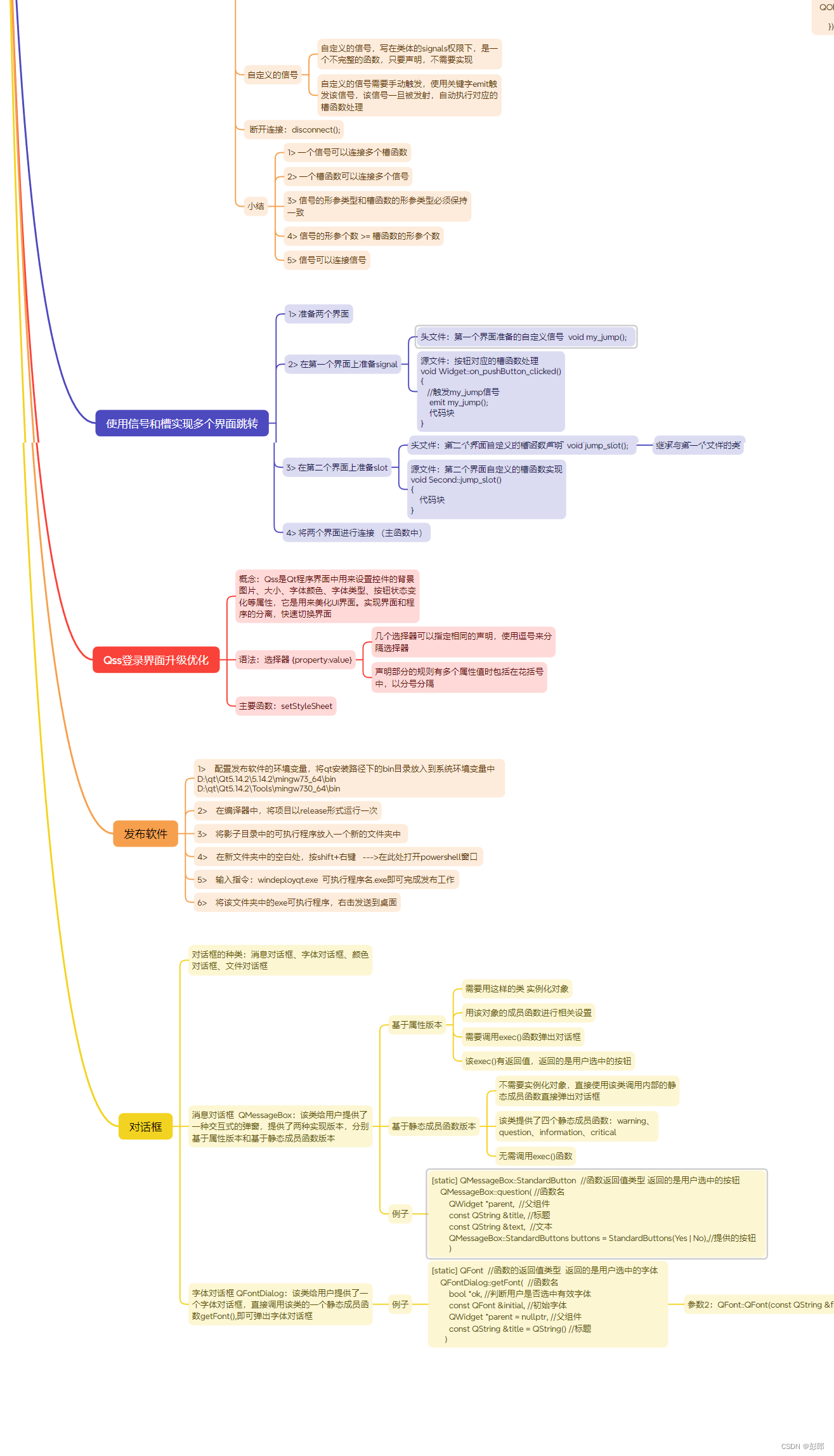12月11日作业
2023-12-15 19:06:39
完善对话框,点击登录对话框,如果账号和密码匹配,则弹出信息对话框,给出提示”登录成功“,提供一个Ok按钮,用户点击Ok后,关闭登录界面,跳转到其他界面
如果账号和密码不匹配,弹出错误对话框,给出信息”账号和密码不匹配,是否重新登录“,并提供两个按钮Yes|No,用户点击Yes后,清除密码框中的内容,继续让用户进行登录,如果用户点击No按钮,则直接关闭登录界面
如果用户点击取消按钮,则弹出一个问题对话框,给出信息”您是否确定要退出登录?“,并给出两个按钮Yes|No,用户迪纳基Yes后,关闭登录界面,用户点击No后,关闭对话框,继续执行登录功能
要求:基于属性版和基于静态成员函数版至少各用一个
第一个头文件
#ifndef WIDGET_H
#define WIDGET_H
#include <QWidget>
#include <QMessageBox>
QT_BEGIN_NAMESPACE
namespace Ui { class Widget; }
QT_END_NAMESPACE
class Widget : public QWidget
{
Q_OBJECT
public:
Widget(QWidget *parent = nullptr);
~Widget();
private slots:
void on_btn_log_clicked();
void on_btn_cancle_clicked();
private:
Ui::Widget *ui;
signals:
void my_jump(); //第一个界面的自定义信号
};
#endif // WIDGET_H
第一个源文件
#include "widget.h"
#include "ui_widget.h"
Widget::Widget(QWidget *parent)
: QWidget(parent)
, ui(new Ui::Widget)
{
ui->setupUi(this);
this->setWindowFlags(Qt::FramelessWindowHint);
this->setAttribute(Qt::WA_TranslucentBackground);
this->setWindowIcon(QIcon(":/pictrue/kunkun.webp"));
}
Widget::~Widget()
{
delete ui;
}
void Widget::on_btn_log_clicked() //登录按钮槽函数
{
//静态成员函数版本
if(ui->edit_id->text() == "admin" && ui->edit_passward->text() == "123456")
{
int ret = QMessageBox::information(this,
"登陆成功",
"确认登录");
if(ret == QMessageBox::Ok)
{
//跳转到其他界面
emit my_jump(); //触发自定义信号
//关闭当前界面
this->close();
}
}
else //登录失败
{
//静态成员函数版本
int ret = QMessageBox::critical(this,
"登录失败",
"账号和密码不匹配,是否重新登录",
QMessageBox::Yes | QMessageBox::No);
if(ret == QMessageBox::Yes)
{
//清空密码,重新登录
ui->edit_passward->clear();
}
else if(ret == QMessageBox::No)
{
//直接关闭
this->close();
}
}
}
void Widget::on_btn_cancle_clicked() //取消按钮槽函数
{
//基于属性版本
QMessageBox msg(QMessageBox::Question,
"取消",
"您是否确定要取消登录?",
QMessageBox::Yes | QMessageBox::No,
this);
//调用exec函数
int ret = msg.exec();
if(ret == QMessageBox::Yes)
{
this->close();
}
}
第二个头文件
#ifndef SECOND_H
#define SECOND_H
#include <QWidget>
namespace Ui {
class Second ;
}
class Second : public QWidget
{
Q_OBJECT
public:
explicit Second(QWidget *parent = nullptr);
~Second();
private:
Ui::Second *ui;
public slots:
void jump_slot(); //自定义的槽函数说明
};
#endif // SECOND_H
第二个源文件
#include "second.h"
#include "ui_second.h"
Second::Second(QWidget *parent) :
QWidget(parent),
ui(new Ui::Second)
{
ui->setupUi(this);
}
Second::~Second()
{
delete ui;
}
//自定义槽函数实现
void Second::jump_slot()
{
this->show(); //第二个界面显示
}
主函数
#include "widget.h"
#include "second.h"
#include <QApplication>
int main(int argc, char *argv[])
{
QApplication a(argc, argv);
Widget w;
w.show();
Second s; //实例化第二个界面
QObject::connect(&w,&Widget::my_jump,&s,&Second::jump_slot);
return a.exec();
}
ui文件

效果演示

君子声明

文章来源:https://blog.csdn.net/m0_56986240/article/details/134934817
本文来自互联网用户投稿,该文观点仅代表作者本人,不代表本站立场。本站仅提供信息存储空间服务,不拥有所有权,不承担相关法律责任。 如若内容造成侵权/违法违规/事实不符,请联系我的编程经验分享网邮箱:veading@qq.com进行投诉反馈,一经查实,立即删除!
本文来自互联网用户投稿,该文观点仅代表作者本人,不代表本站立场。本站仅提供信息存储空间服务,不拥有所有权,不承担相关法律责任。 如若内容造成侵权/违法违规/事实不符,请联系我的编程经验分享网邮箱:veading@qq.com进行投诉反馈,一经查实,立即删除!